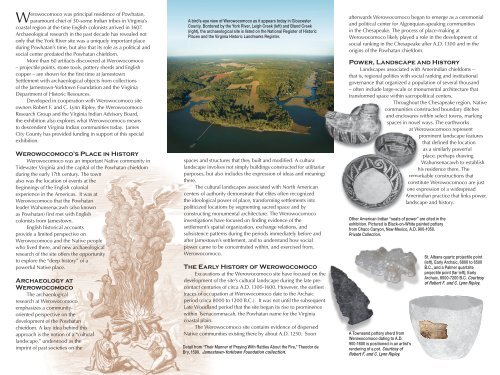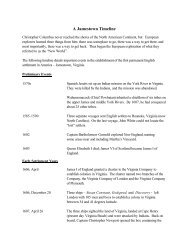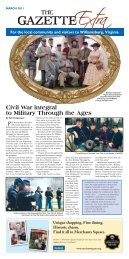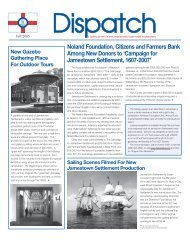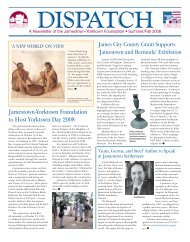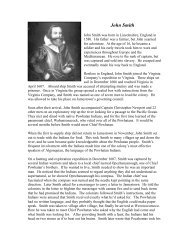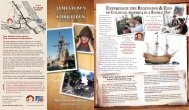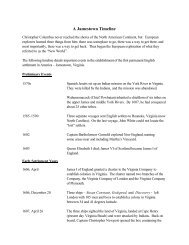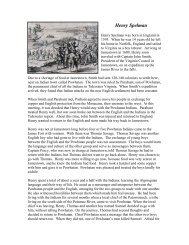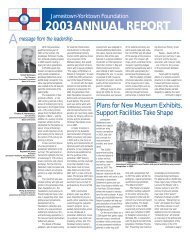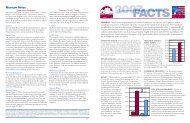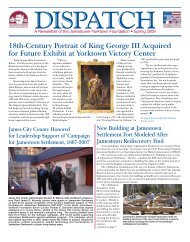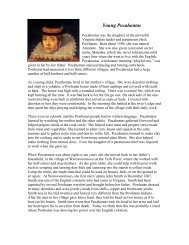exhibition brochure - Jamestown Settlement
exhibition brochure - Jamestown Settlement
exhibition brochure - Jamestown Settlement
Create successful ePaper yourself
Turn your PDF publications into a flip-book with our unique Google optimized e-Paper software.
Werowocomoco was principal residence of Powhatan,<br />
paramount chief of 30-some Indian tribes in Virginia’s<br />
coastal region at the time English colonists arrived in 1607.<br />
Archaeological research in the past decade has revealed not<br />
only that the York River site was a uniquely important place<br />
during Powhatan’s time, but also that its role as a political and<br />
social center predated the Powhatan chiefdom.<br />
More than 60 artifacts discovered at Werowocomoco<br />
– projectile points, stone tools, pottery sherds and English<br />
copper – are shown for the first time at <strong>Jamestown</strong><br />
<strong>Settlement</strong> with archaeological objects from collections<br />
of the <strong>Jamestown</strong>-Yorktown Foundation and the Virginia<br />
Department of Historic Resources.<br />
Developed in cooperation with Werowocomoco site<br />
owners Robert F. and C. Lynn Ripley, the Werowocomoco<br />
Research Group and the Virginia Indian Advisory Board,<br />
the <strong>exhibition</strong> also explores what Werowocomoco means<br />
to descendent Virginia Indian communities today. James<br />
City County has provided funding in support of this special<br />
<strong>exhibition</strong>.<br />
Werowocomoco’s Place in History<br />
Werowocomoco was an important Native community in<br />
Tidewater Virginia and the capital of the Powhatan chiefdom<br />
during the early 17th century. The town<br />
also was the location of events at the<br />
beginnings of the English colonial<br />
experience in the Americas. It was at<br />
Werowocomoco that the Powhatan<br />
leader Wahunsenacawh (also known<br />
as Powhatan) first met with English<br />
colonists from <strong>Jamestown</strong>.<br />
English historical accounts<br />
provide a limited perspective on<br />
Werowocomoco and the Native people<br />
who lived there, and new archaeological<br />
research of the site offers the opportunity<br />
to explore the “deep history” of a<br />
powerful Native place.<br />
Archaeology at<br />
Werowocomoco<br />
The archaeological<br />
research at Werowocomoco<br />
emphasizes a communityoriented<br />
perspective on the<br />
development of the Powhatan<br />
chiefdom. A key idea behind this<br />
approach is the notion of a “cultural<br />
landscape,” understood as the<br />
imprint of past societies on the<br />
A bird’s-eye view of Werowocomoco as it appears today in Gloucester<br />
County. Bordered by the York River, Leigh Creek (left) and Bland Creek<br />
(right), the archaeological site is listed on the National Register of Historic<br />
Places and the Virginia Historic Landmarks Register.<br />
spaces and structures that they built and modified. A cultural<br />
landscape involves not simply buildings constructed for utilitarian<br />
purposes, but also includes the expression of ideas and meanings<br />
there.<br />
The cultural landscapes associated with North American<br />
centers of authority demonstrate that elites often recognized<br />
the ideological power of place, transforming settlements into<br />
politicized locations by segmenting sacred space and by<br />
constructing monumental architecture. The Werowocomoco<br />
investigations have focused on finding evidence of the<br />
settlement’s spatial organization, exchange relations, and<br />
subsistence patterns during the periods immediately before and<br />
after <strong>Jamestown</strong>’s settlement, and to understand how social<br />
power came to be concentrated within, and exercised from,<br />
Werowocomoco.<br />
The Early History of Werowocomoco<br />
Excavations at the Werowocomoco site have focused on the<br />
development of the site’s cultural landscape during the late precontact<br />
centuries of circa A.D. 1300-1600. However, the earliest<br />
traces of occupation at Werowocomoco date to the Archaic<br />
period (circa 8000 to 1200 B.C.). It was not until the subsequent<br />
Late Woodland period that the site began its rise to prominence<br />
within Tsenacommacah, the Powhatan name for the Virginia<br />
coastal plain.<br />
The Werowocomoco site contains evidence of dispersed<br />
Native communities existing there by about A.D. 1250. Soon<br />
Detail from “Their Manner of Praying With Rattles About the Fire,” Theodor de<br />
Bry, 1590. <strong>Jamestown</strong>-Yorktown Foundation collection.<br />
afterwards Werowocomoco began to emerge as a ceremonial<br />
and political center for Algonquian-speaking communities<br />
in the Chesapeake. The process of place-making at<br />
Werowocomoco likely played a role in the development of<br />
social ranking in the Chesapeake after A.D. 1300 and in the<br />
origins of the Powhatan chiefdom.<br />
Power, Landscape and History<br />
Landscapes associated with Amerindian chiefdoms –<br />
that is, regional polities with social ranking and institutional<br />
governance that organized a population of several thousand<br />
– often include large-scale or monumental architecture that<br />
transformed space within sacropolitical centers.<br />
Throughout the Chesapeake region, Native<br />
communities constructed boundary ditches<br />
and enclosures within select towns, marking<br />
spaces in novel ways. The earthworks<br />
at Werowocomoco represent<br />
prominent landscape features<br />
that defined the location<br />
as a similarly powerful<br />
place, perhaps drawing<br />
Wahunsenacawh to establish<br />
his residence there. The<br />
remarkable constructions that<br />
constitute Werowocomoco are just<br />
one expression of a widespread<br />
Amerindian practice that links power,<br />
landscape and history.<br />
Other American Indian “seats of power” are cited in the<br />
<strong>exhibition</strong>. Pictured is Black-on-White painted pottery<br />
from Chaco Canyon, New Mexico, A.D. 900-1050.<br />
Private Collection.<br />
A Townsend pottery sherd from<br />
Werowocomoco dating to A.D.<br />
900-1600 is positioned in an artist’s<br />
rendering of a pot. Courtesy of<br />
Robert F. and C. Lynn Ripley.<br />
St. Albans quartz projectile point<br />
(left), Early Archaic, 6800 to 6500<br />
B.C., and a Palmer quartzite<br />
projectile point (far left), Early<br />
Archaic, 8000-7200 B.C. Courtesy<br />
of Robert F. and C. Lynn Ripley.
Werowocomoco and Our<br />
Understanding of Virginia’s Past<br />
Archaeological and documentary evidence provides<br />
a basis for a deeper sense of Werowocomoco as a Native<br />
place, a place that is not recognizable from English historical<br />
accounts alone. Archaeological investigations indicate that,<br />
approximately 300 years before the English came to Virginia,<br />
the residents of Werowocomoco changed and reorganized<br />
their town as it became an important regional center,<br />
constructing an earthwork enclosure there to separate the<br />
residential portion of the town from what appears to be a<br />
ceremonial enclosure. Later, in the early<br />
17th century, a large structure was built<br />
within this enclosure, providing clear<br />
evidence of status differences within<br />
the settlement.<br />
A large quantity of copper recovered from the<br />
site is of European manufacture and has the<br />
same chemical composition as similar copper<br />
pieces found at <strong>Jamestown</strong>. Copper alloy<br />
pieces, shown here rolled into a bead and in<br />
a sheet, found at Werowocomoco, 17th century,<br />
Europe. Courtesy of Robert F. and C. Lynn Ripley.<br />
Captain John Smith’s Journey<br />
to Werowocomoco<br />
In December 1607, Captain John Smith<br />
was captured by Opechancanough, the brother<br />
of Wahunsenacawh, paramount chief of the<br />
Powhatan. In the following weeks Smith was<br />
taken by a circuitous route to Werowocomoco,<br />
designed by his captors to both teach Smith<br />
about the Powhatan world and to bring<br />
him, through ritual and symbolism, into<br />
a new relationship with that world.<br />
On his part, Captain John Smith<br />
Ivory diptych compass and<br />
sundial, German, early 17th<br />
century. <strong>Jamestown</strong>-Yorktown<br />
Foundation collection.<br />
saw his captivity as an opportunity<br />
to develop a different sort of<br />
relationship with the Virginia Indians<br />
that would serve the interests of<br />
the <strong>Jamestown</strong> colonists. In effect,<br />
Smith presented the Powhatan Indians with a competing world<br />
view based on European concepts of science, geography and<br />
history. One of the ways Smith communicated with the Indians<br />
was by showing them his ivory pocket compass, in which he<br />
demonstrated “the roundness of the earth and skies, … the<br />
greatness of the land and sea, the diversity of nations.” What<br />
resulted was a far-ranging exchange of ideas and belief systems<br />
between Smith and the Powhatan Indians that must have been<br />
heavily dependant on symbolism and analogy, since neither<br />
side knew much of the other’s language.<br />
Cover: Powhatan at Werowocomoco, detail from John Smith’s Map<br />
of Virginia, 1612. <strong>Jamestown</strong>-Yorktown Foundation collection.<br />
Werowocomoco and the<br />
Virginia Indian Community<br />
Virginia’s Indian community has an enduring and powerful<br />
connection to Werowocomoco not just as the historic center<br />
of the Powhatan chiefdom, but also as a modern place for<br />
renewing Virginia Indians’ influence on representations of<br />
the Native past. The Werowocomoco Research Group – a<br />
collaboration of researchers from the Fairfield Foundation, the<br />
Virginia Department of Historic Resources and the College<br />
of William and Mary – has worked over the past decade<br />
to develop an archaeological project built around close<br />
partnerships with representatives from six of the Powhatan<br />
descendent communities. At Werowocomoco, new forms of<br />
collaborative and consultative archaeology are emerging that<br />
combine indigenous values with academic research. This<br />
special <strong>exhibition</strong> makes it accessible to the public. ❖<br />
Learn More<br />
The story of Powhatan Indians in 17th-century Virginia<br />
is examined in <strong>Jamestown</strong> <strong>Settlement</strong> permanent gallery<br />
exhibits and a re-created Powhatan Indian village,<br />
where historical interpreters discuss and demonstrate the<br />
Powhatan way of life.<br />
<strong>Jamestown</strong> <strong>Settlement</strong> and Yorktown Victory Center living-history<br />
museums are administered by the <strong>Jamestown</strong>-Yorktown Foundation,<br />
an educational institution of the Commonwealth of Virginia,<br />
accredited by the American Association of Museums, that fosters<br />
awareness and understanding of the early history of the United States<br />
and the enduring legacies bequeathed to the nation.<br />
<strong>Jamestown</strong> <strong>Settlement</strong> interprets the founding of <strong>Jamestown</strong>,<br />
America’s first permanent English settlement, and the diverse<br />
cultures, including Powhatan Indian, African and European, that<br />
converged in 17th-century Virginia. The Yorktown Victory Center<br />
tells the story of the American Revolution and the development of<br />
the new nation.<br />
<strong>Jamestown</strong>-Yorktown Foundation<br />
P.O. Box 1607<br />
Williamsburg, VA 23187<br />
(757) 253-4838 toll-free (888) 593-4682<br />
www.historyisfun.org<br />
35M:4/10<br />
JA M E S T O W N SE T T L E M E N T<br />
SPECIAL EXHIBITION<br />
May 15 through November 15, 2010<br />
WEROWOCOMOCO:<br />
SEAT OF<br />
POWER<br />
At the time <strong>Jamestown</strong>, America’s first permanent<br />
English colony, was founded in 1607, the center of<br />
power in coastal Virginia was at Werowocomoco,<br />
principal residence of Powhatan, the region’s<br />
paramount chief. The importance of this location in<br />
Virginia Indian history and its role in early contact<br />
between Powhatan and English cultures is explored<br />
in “Werowocomoco: Seat of Power,” where artifacts<br />
spanning close to 10,000 years are on exhibit for the<br />
first time in a museum setting.


